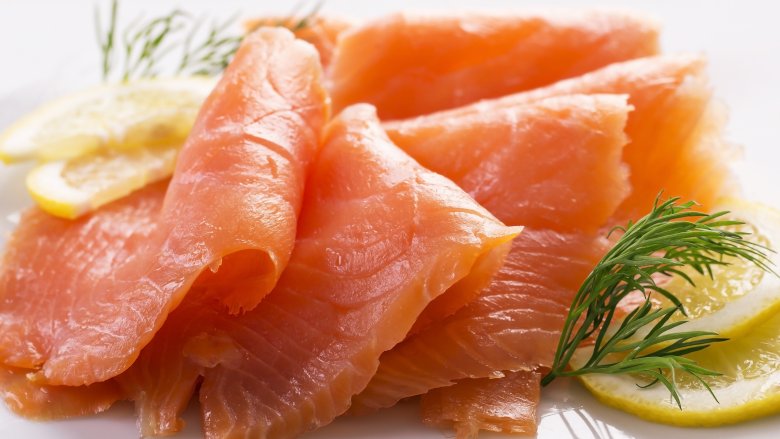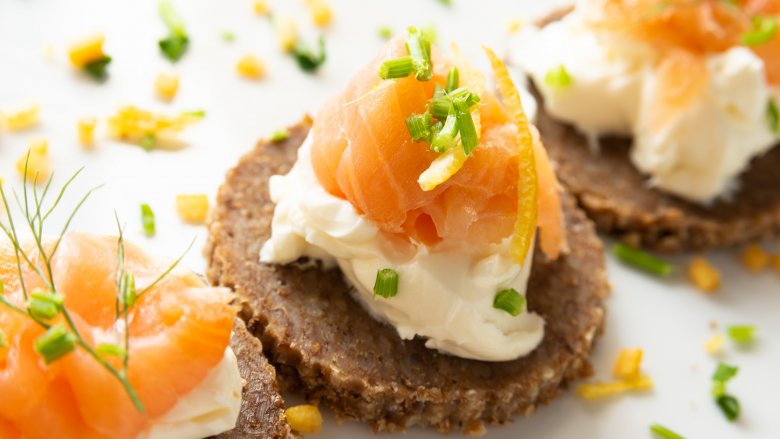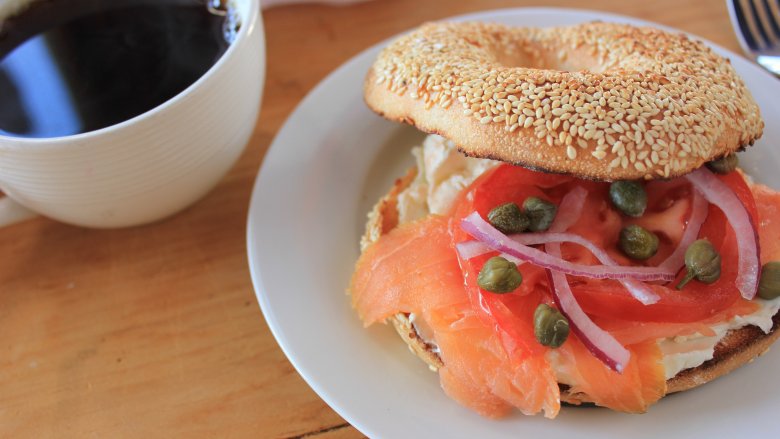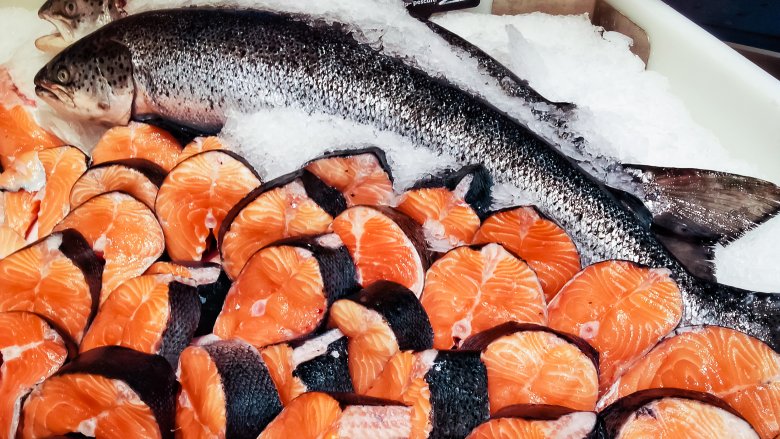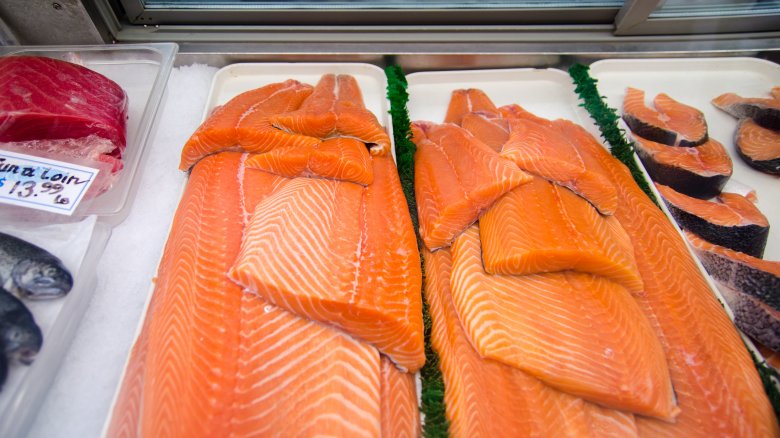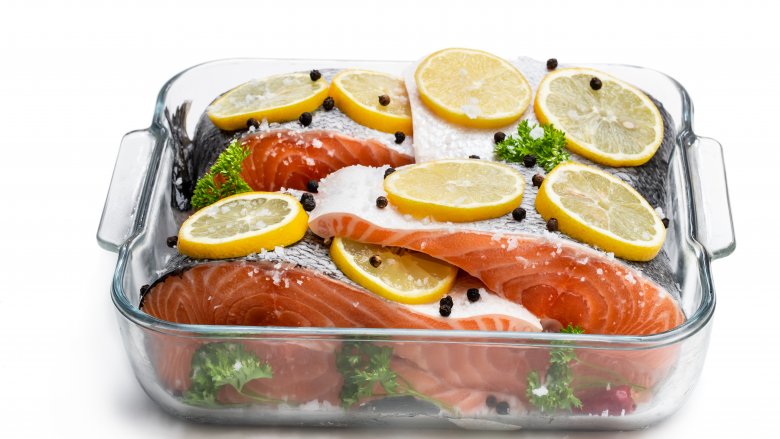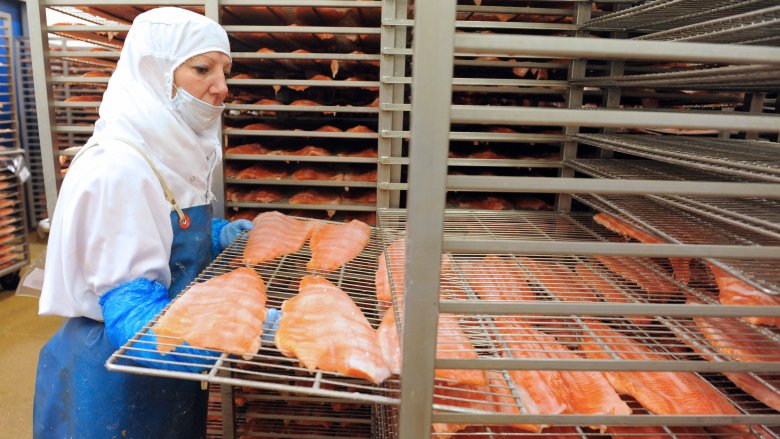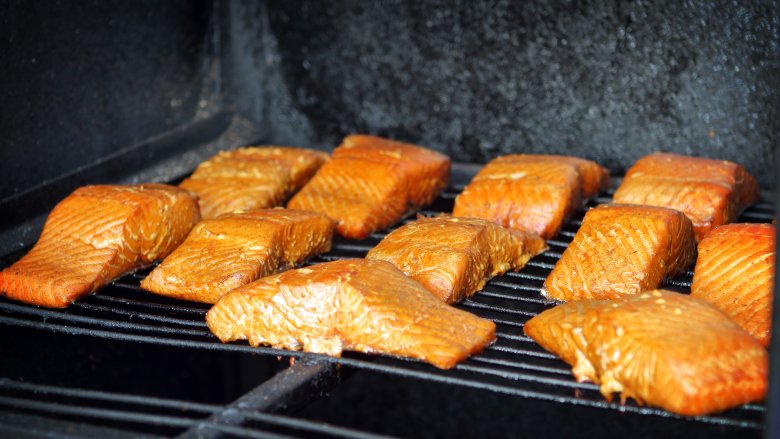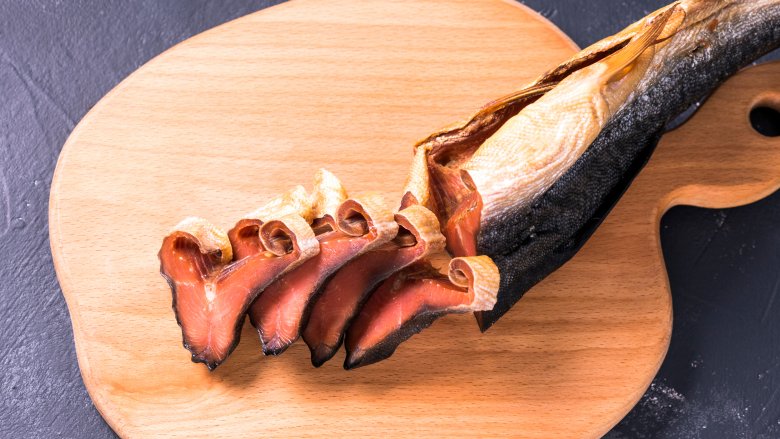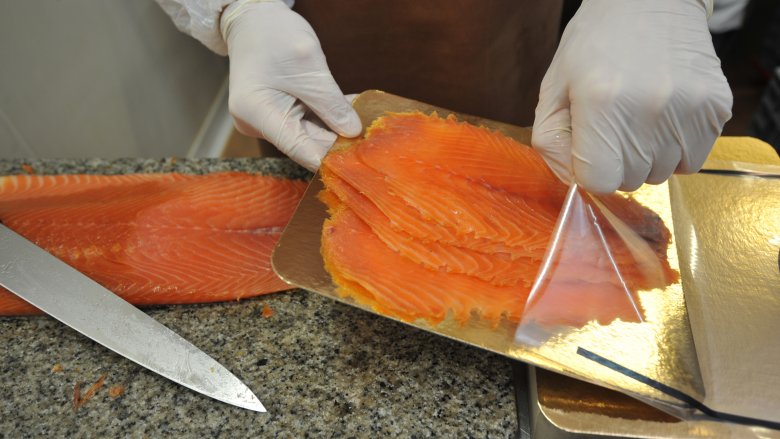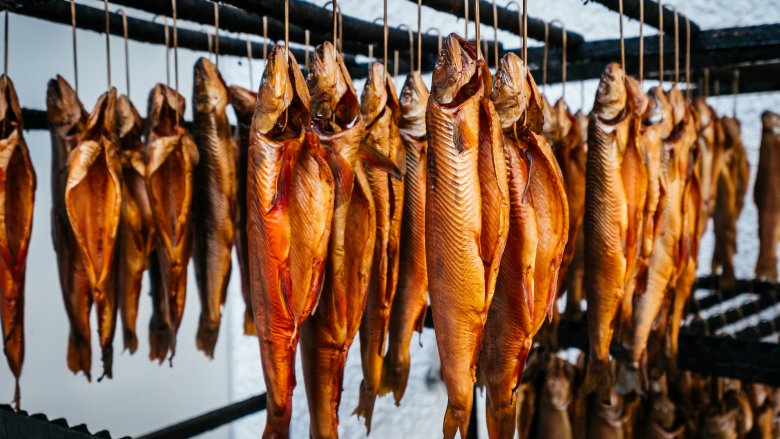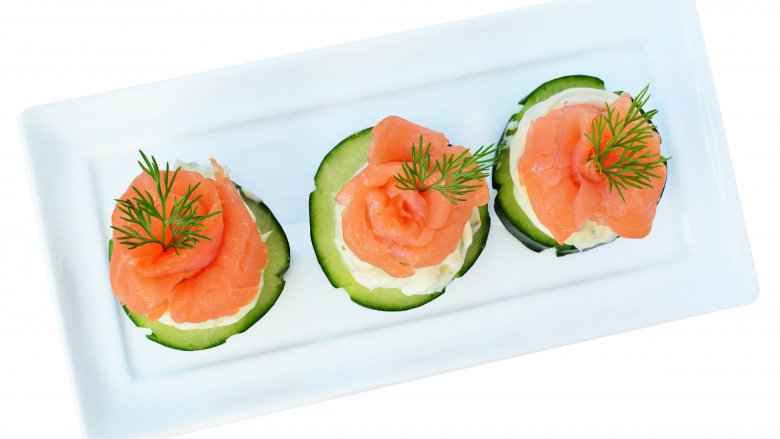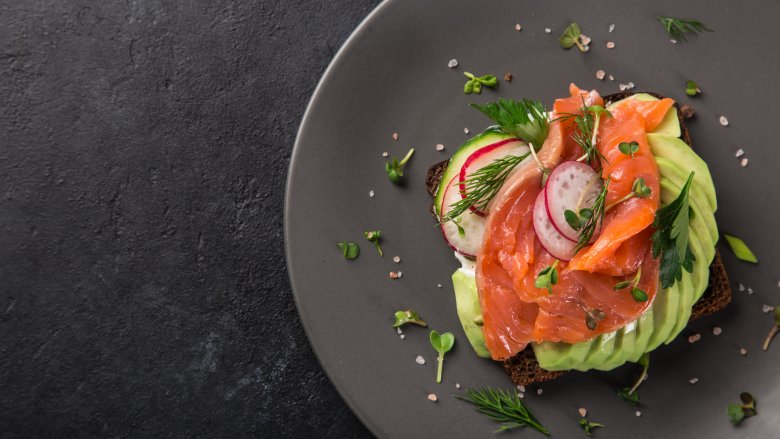This Is How Smoked Salmon Is Really Made
It's hard to imagine a time when we had to salt and smoke meat as a method of preservation. Today, we smoke foods like salmon to add flavor to our meals. A bagel and cream cheese is just okay, but add a few slices of lox, capers, and red onions to the mix, and you have something magical. Toss it in your favorite salads, sandwiches, frittatas, deviled eggs, or soup; you name it, and smoked salmon will probably make it better. But it wasn't always this way: back in the day, people cured salmon in smoke to preserve it. According to The New York Times, the Indians in the Pacific Northwest smoked salmon for two weeks so it would keep without refrigeration. It was likely tough and less palatable than fresh salmon, but it wouldn't spoil over time.
As time went on, we've refined our salmon smoking process until it's pretty well perfected (and, if we don't mind saying, completely delicious). What starts as a regular piece of salmon and a handful of salt turns into a flavorful, texturally rich eating experience. And depending on which twists and turns you take along the way, your fillet can become a cured fish like lox or gravlax, go the cold-smoked route and gain a silken, melt-in-your-mouth texture, or join the ranks of sweet and salty, flaky hot-smoked salmon. Here's how you get there.
Smoked salmon is a generic term
First thing's first: what do we mean when we say "smoked salmon?" It turns out that's a pretty generic term that could refer to any number of products. The fish itself could be farm-raised or wild-caught, and the form could be cut into fillets or sliced into steaks. Then there's the cooking method; some smoked salmon is cured and cold-smoked to create a raw (but edible) fish with a sushi-like texture, while others are cooked over hot smoke and turn out firm and flaky.
When it comes down to it, there are three major types of smoked salmon: cold-smoked, hot-smoked, and salt-cured lox and gravlax (which aren't actually smoked at all). They all start out the same way: the fish is brined in a salt solution to pull out the moisture and prevent the growth of bacteria. After that, hot- and cold-smoked fish are dried and smoked, but lox takes a different path.
What makes lox different from other smoked salmon?
According to Moment magazine, lox was invented when salmon from the Pacific Northwest was shipped east packed in salt. The salt pulled the moisture from the fish resulting in a brine that preserved the salmon for months. It was salty, affordable, and pareve, so it became popular among Jewish immigrants because they could eat it with dairy. This type of "smoked salmon" often isn't actually smoked at all, but cured (similar to the Swedish dill-cured salmon, gravlax). We're not exactly sure how it got lumped into the smoked salmon category, but it's almost always made with salmon belly, the fattiest, most flavorful part of the fish.
To make things more complicated, there's another version of lox — Nova lox — that gained popularity with the advent of refrigeration. Because it was no longer necessary to brine the fish as a method of preservation, smokehouses reduced the amount of salt they used to cure the fish and cold smoked it to deepen the flavor. Traditionally, you won't find Nova made from belly, though; that's still reserved for the real-deal lox.
Proper prep is the key to perfectly smoked salmon
Now that we've cleared that up, let's talk about the first step in making smoked salmon. While you could technically smoke the salmon whole, you wouldn't really want to. It's easier to find the bones and remove them before you smoke a fish, plus there's the whole skin-on or skinless debate (which we'll dive into in a moment). You could cut the fish into steaks, but the most popular way to smoke salmon is by removing the meaty fillets on each side of the backbone. Most fish fillets (including the ones you buy at the store) still contain a few tiny bones called pin bones. They're super easy to remove if you drape the filet over an upside-down bowl and remove the protruding bones using a pair of tweezers, as Tasting Table recommends.
Now it's time to decide whether you want to smoke the salmon with the skin on or off. Thermoworks advises that keeping the skin on helps the meat hold together as it cooks, but the salmon absorbs the cure better without it. The skin can also lead to off flavors, and although it does have nutrient value, the skin can become soggy and chewy when smoked. Since most people don't eat the skin on cooked fish anyway, we'd just as soon remove it now rather than later.
Any type of salmon works for smoking
Since salmon's flavor gets concentrated as it cures and smokes, the type of salmon you choose has a lot to do with the flavor you end up with. That said, you can make smoked salmon out of any kind, so use what you have. Keep in mind that each salmon species has a unique oil content. Salmon with a lot of oil (like king or sockeye) is more full-flavored and will retain its moisture more efficiently as it smokes. Salmon like Atlantic or coho are lower in oil with a pale color and a more mild flavor. These fish are best for those who prefer a lighter fish and a dryer texture.
While you want the salmon to be fresh, that doesn't mean it can't be frozen. If your choices are smelly "fresh" fish or pristine frozen fish, the latter is the better choice every time. The flavor of the salmon will intensify as it goes through the smoking process, and if it developed an off, fishy flavor because it was spoiling, it definitely won't taste very good after it's smoked. Because freezing fish causes the cells to burst, it actually allows the fish to take in more of the brine and smoke flavors, too. You'll just want to make sure the fish is fully thawed before moving on to the next step, as salt can't penetrate frozen tissue.
Smoked salmon requires a lot of salt (and sugar)
After preparing the salmon fillet, the next step is to apply salt to the fish. Salt gets a bad rap, but its importance in seasoning and preservation cannot be underplayed.
There are two ways to cure salmon: wet or dry. Applying a dry cure means covering the fish in salt (and maybe some sugar and seasonings) and rinsing off the excess after a long period of time — anywhere between an hour and a full day.
With a wet cure, a brine is prepared using salt and sugar, and the salmon is submerged in the liquid for around six to 10 hours. By the end of the brining process, the salt has done a lot for your piece of salmon. Not only does it remove some of the moisture, helping to stay fresh longer and tolerate the smoking process better, but it also improves and intensifies the flavor. The sugar has a job to do, too, aside from adding some sweet flavor. Sugar helps the salmon absorb moisture, allowing it to take on some of the wet brine after the salt has pushed out the fish's original moisture.
Once the salmon is cured, you have to dry it
We're really close to tossing that fish on the smoker! Now that's it's been cured, there's only one more step before we can add that delicious, smoky flavor. It's time to develop the pellicle, a skin that forms on the surface of food as it's exposed to air and moisture is removed. Professional kitchens often use a fan and higher temperatures to form a pellicle on salmon in as little as 30 minutes, but most at-home recipes call for drying salmon at room temperature for one to three hours.
This might seem like a step you could skip if you're in a hurry, but that protective layer has a few functions. First, it traps moisture inside the fish, ensuring that your final smoked salmon will be moist despite the long smoke time. It also gives the finished product an attractive glean and helps the smoke adhere to the meat as it cooks, making your smoked salmon that much more flavorful.
It's finally time to smoke the salmon
After it's properly dried, we're finally ready to smoke the salmon. Alder a popular wood for smoking salmon, but you can use any type of hardwood you like. Some companies prefer maple or apple wood because it gives the fish a sweet characteristic. Using fir, pine, spruce, or cedar is not recommended, as these woods can impart bad flavors and give the fish an unpalatable finish.
At this point, it's time to decide if you're using hot or cold smoke. The two types of smoking produce a fish with different tastes and textures. Keep in mind that the cold-smoking process doesn't actually cook the fish, so it comes with some risks associated with bacteria and food-borne illness. We'll dive into cold smoking in a minute, but first, let's walk through how to hot smoke salmon.
The Kitchn recommends setting your smoker to 150-160 degrees Fahrenheit and smoking the fish until it reaches an internal temperature of 140 degrees at its thickest point. Depending on the thickness of the fillet, this should take about one to three hours. If you want to infuse more smoky flavor into your fish, you can lower the temperature to 90 degrees for the first two hours. With either method, you'll have to then cook the fish in your oven until the salmon reaches 150 degrees at it's thickest point. This makes is safe for eating, but it can also dry out the fish. Stay near by and attentive during this part of the process.
Cold-smoked salmon is technically raw
Cold-smoked salmon is tasty, but it's riskier than its hot-smoked cousin. That's because with cold smoking, the smoker never reaches temperatures above 80 degrees Fahnerheit. You see, food needs to be above 140 degrees Fahrenheit or below 40 degrees to stay out of the so-called "danger zone." Bacteria responsible for foodborne illness grows rapidly inside this range (according to the United States Department of Agriculture (USDA), they can double in number in a little as 20 minutes). Not only that, but the USDA's minimum internal cooking temperature for fish is 145 degrees, which means cold-smoked salmon is technically raw.
It's not all bad, though. The lack of heat gives the salmon a vibrant color. It also retains more moisture, giving it a textural leg-up on flaky hot-smoked salmon, and it kind of melts in your mouth as you eat it. Because you took the time to cure the fish, it is usually safe to eat, although extreme care should be taken when handling this unpasteurized fish. So long as you've practiced good sanitation, bought it from a source that you trust, and don't have a compromised immune system, eating it shouldn't be a problem.
When it's finished, enjoy it straight away, or wrap it up and store it
The hard part is done: Now that the fish is smoked, you can eat both cold- and hot-smoked salmon right away, if you prefer. Slice it thinly for the traditional bagel with cream cheese and capers, add it to your favorite pasta for dinner, or pulse it in a food processor and serve the dip as an appetizer.
Any fish you're not planning to eat straight away should be cooled and stored. The difference in temperature between the refrigerator and the fish can cause condensation in the packaging, so Food Safety News recommends cooling hot-smoked salmon to at least 110 degrees Fahrenheit or colder before placing it in plastic bags, air-tight containers, or vacuum-sealed packages. This isn't a problem for cold-smoked salmon. Since it was only cooked to 80 degrees, you should be able to package it straight away.
Although it's fully preserved, home-smoked salmon it won't last too much longer than raw salmon. Store it in the refrigerator for up to two weeks. If you want to hold onto it longer than that, wrap it tightly in plastic wrap or place it in a freezer bag. It will keep frozen for about a year.
Smoked salmon is so expensive because the fish loses weight
Salmon prices vary widely depending on quality and availability. As of June 2019, salmon was available from $8 to $12 per pound for Atlantic (farmed) salmon (depending on the season and location), and $11 to $20 for wild-caught varieties. An online retailer listed a whole side of smoked salmon for $29 per pound, and smoked salmon jerky was the most expensive at $48 per pound. You might expect the smoked varieties to be a little more pricey consider how much work it took to salt, dry, and smoke the fish. But is it reasonable to charge that much more?
It is when you consider how much less the fish weighs after all this. There's a lot of waste involved in processing fish. The European non-profit media agency, Youris.com, estimates that only 50 percent of every salmon is eaten: the heads, skin, and bones are undesirable and are usually discarded instead of being turned into a value-added products. Not only that, but fish lose additional weight as they're salted and smoked, about 16 to 18 percent. That means an average, 30-pound salmon will yield as little as 12 pounds of edible smoked salmon. To put it in more relatable terms, each one-pound salmon fillet from the store turns into 13 ounces of smoked salmon, effectively losing a portion size. No wonder the prices are significantly higher per pound for smoked salmon.
Smoked salmon may not be as healthy as uncured salmon
If you're hoping to increase your consumption of omega-3 fatty acids, salmon is a great way to go. Salmon is one of the most nutrient-dense foods you can eat, thanks to its high-quality protein and high levels of B vitamins and minerals like potassium and selenium. It's also a great source of heart-friendly omega-3 fatty acids, which can reduce inflammation and lower blood pressure.
So why not eat smoked salmon with every meal? Sadly, all that salt we used to keep salmon safe from bacteria is not great for our bodies. The Globe and Mail estimates 666 milligrams of sodium in each three-ounce serving of smoked salmon. Compare that to the 50 milligrams you'd receive from fresh salmon, and the comparison is staggering. There is also some concern that commercial manufacturers add nitrites to smoked salmon products, which have been linked to cancer.
Should you eat it? Absolutely, but (like most delicious things) probably in moderation. If you're at risk for listeria food poisoning, you might want to steer clear of the cold-smoked varieties because of their unpasteurized status. There are plenty of tasty hot-smoked salmon options, or you can try cooking your salmon in another tasty way.
There are so many ways to use smoked salmon
Even though smoked salmon is more expensive than its fresh counterpart, it's nowhere near as pricey as seafood specialties like caviar and sushi-grade tuna. And yet, smoked salmon has a fancy feel about it (not to mention a delectable flavor). As a bonus, the ingredient is dietary-restriction-friendly; pescatarians and meat eaters alike love it, and it's naturally gluten-free and low-carb. Throw a dinner party and use smoked salmon in every course, and you're unlikely to receive any complaints.
For breakfast, the bagel, cream cheese, and smoked salmon combo is hard to beat, but we love chopping it and folding into scrambled eggs as an easy way to elevate a simple dish. Get fancier with it and design a benedict with hollandaise around it, or whip up an asparagus and salmon frittata. If you're looking for a quick snack or an easy appetizer, smoked salmon is the perfect way to fancy up stuffed mushrooms, or you can serve it on toast with sliced avocado and a few radishes for color. For a fun little party bite, spread sour cream or cream cheese over cucumber coins and top them with a bit of smoked salmon. As far as heartier mains go, feel free to use in place of bacon in your favorite recipes. You can't go wrong with smoked salmon chowder, using it as a pizza topping, or stuffing it inside potatoes for a fun riff on loaded baked potatoes.
